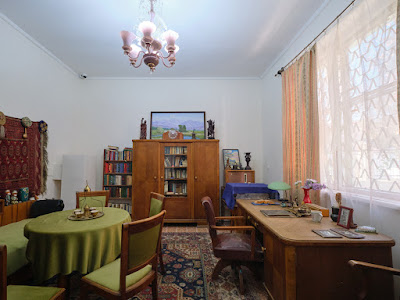Follow our adventures as we share our thoughts, impressions and awe at what could be called: Foreign Service's Wide World of Talalay.
Thursday 28 July 2022
Buddhist Fayaz Tepe
Tuesday 26 July 2022
The Mausoleum Of Al Hakkim Al Termezi
The devotees trickle in.
Design-wise, the mausoleum is standard Silk Road era fare, tan brick, central dome.
Interior view of the central dome. The grounds around the mausoleum are expansive and include a modern entrance gate with a bit of an Arabian Nights fantasy wall.
Thursday 21 July 2022
Curious Kyr Kyz
Tuesday 19 July 2022
Swanky Sultan Saodat Complex
Thursday 14 July 2022
Treasuring The Archaeological Museum In Termez
Little city of Termez, nestled way down by the Amu Darya river and Afghanistan, has one of the better museums in Tashkent. It's all about location and Termez is in the center - a sort of intersection crossed by multiple religious movements - all at the whims of Silk Road peeps.
Welcome!
The museum concentrates on ancient history, mostly the time leading up to the Silk Road era. Like this fella. Or foot.
Lovely Khalchayan terra cotta statue. 1st Century BC. Round bling, commonly called coins.
Tuesday 12 July 2022
Digging The Dancer Tamara Khanum
Finally, a house museum dedicated to someone other than a broody writer. Swing it, baby! Tamara Khanum was a famous dancer, daring to frolic on stage without donning the traditional, body covering robe, a paranja. The Madonna of Uzbekistan in the 1920s.
The main room of the house museum, now a hall of fame for her various costumes.
Many portraits are at the museum, each one more flattering than the last. Khanum could strike a pose. The music section.
ID cards. One is always a Comrade. The top one is for being in the theater union. The bottom ID is her employee card while working at the ministry of health back in the 1970s. Another portrait, now a Grande Dame.
Thursday 7 July 2022
A House Sergei Yesenin Visited
Why stop at making museums out of houses where writers lived? Visited is good enough, right? Behold the Sergei Yesenin museum in Tashkent. Why? It seems the acclaimed Russian poet, Yesenin, visited his buddy, Alexander Shiryaevets, there in Tashkent in May 1921. Boom, museum to you!
Perhaps Yesenin gets a museum due to his fame as one of Russia's most beloved poets, a writer of lyrical works of village life in the face of urbanization, industrialization. Comrade, tells of the olde days. And then there's the untimely death at age 30 in a hotel room in Leningrad, ruled a suicide, perhaps political murder. Four wives by then. The James Dean, Oscar Wilde of Russian poetry. Scandal!
Portrait of a rebel poet as a young man.
If only the humble Tashkent museum was as exciting. Some blah exhibits in a few rooms.
Old pictures offer a more direct connection. School chums and past loves?
Tuesday 5 July 2022
Visiting The House Of Russian Writer Sergey Borodin
Another day in Tashkent, another writer's house to visit. How about Sergey Borodin? Born: 1902, Moscow. A childhood in Belyaev. Most famous for writing the historical works, "Dmitry Donskoi" and "The Stars Over Samarkand." Moved to Tashkent in 1951 and died at his home in 1974. The End.
Big Dining Room, perhaps also used as the Living Room.
Room for endless tchotchkes. In the library, taking the phrase, "shot of whiskey," to its literal end.
Writing study. The daily paper calendar, stuck on June 22, 1974, the day Borodin died.























































